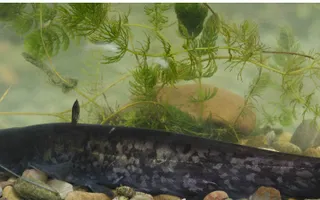The UK's northern location, cooler temperatures and lack of food availability inhibits the size these giants can grow to. In Europe, with warm water and plenty of food, these fish can reach weights of up to 674lb.
Appearance: catfish are easily identified, with long slender bodies, broad heads, wide mouths and long slender barbels. The Wels catfish has two long barbels on the upper jaw and four shorter barbels on the lower jaw. These barbels are used to hunt and detect prey. The body is dark brown to black in colour, with a soft yellow to white belly. The anal fin is long (usually half the length of the body) and finishes right at the base of the tail fin.
British record: 62lb (British Record Fish Committee January 2015) 100lb+ fish have been recorded but not accepted due to being illegally introduced to the water
Lateral line scale count: 33-40 (this is the dark row of scales along the central length of the fish's body)
Lifespan: up to 90 years
How to catch a catfish
Catfish can be large and are very powerful, so strong tackle is essential. They prefer to hunt in murky waters and primarily feed during the night. They use their long, highly sensitive barbels to sense their surroundings and search out resting fish and other food sources. Smelly dead baits and fishing tactics similar to those used for large pike or zander are very successful. In recent years, large pellets have been used to great effect and seem to be the preferred method now. Use a hook larger than a size 2 and fish a couple of large 25+mm hair rigged pellets.
Where to catch a catfish
Marsworth Reservoir, near Tring, has a small population of catfish that were introduced legally by the Rothschild family, who controlled the sporting rights on the Tring Reservoir complex for many years.






